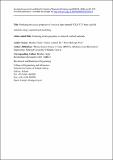Predicting the elastic properties of selective laser sintered PCL/b-TCP bone scaffold materials using computational modelling.
Date
2013Author
Doyle, Heather
Lohfeld, Stefan
McHugh, Peter E.
Metadata
Show full item recordUsage
This item's downloads: 640 (view details)
Cited 29 times in Scopus (view citations)
Recommended Citation
Doyle, H., Lohfeld, S., McHugh, P.E. (2013) 'Predicting the elastic properties of selective laser sintered PCL/b-TCP bone scaffold materials using computational modelling'. Annals Of Biomedical Engineering, 42 (3):661-677.
Published Version
Abstract
Abstract This study assesses the ability of finite element (FE) models to capture the mechanical behaviour of sintered orthopaedic scaffold materials. Individual scaffold struts were fabricated from a 50:50 wt% poly-e-caprolactone (PCL)/b-tricalcium phosphate (b-TCP) blend, using selectivelaser sintering. The tensile elastic modulus of single struts was determined experimentally. High resolution FE models of single struts were generated from micro-CT scans (28.8 lmresolution) and an effective strut elastic modulus was calculated from tensile loading simulations. Three material assignment methods were employed: (1) homogeneous PCL elastic constants, (2) composite PCL/b-TCP elastic constants based on rule of mixtures, and (3) heterogeneous distribution of micromechanically-determined elastic constants. In comparisonwith experimental results, the use of homogeneous PCL properties gave a good estimate of strut modulus; however it is not sufficiently representative of the real material as it neglects the b-TCP phase. The rule of mixtures method significantly overestimated strut modulus, while there was no significant difference between strut modulus evaluated using the micromechanically-determined elastic constants and experimentally evaluated strut modulus. These results indicate that the multi-scale approach of linking micromechanical modelling of the sintered scaffold material with macroscale modelling gives an accurate prediction of the mechanical behaviour of the sintered structure.


